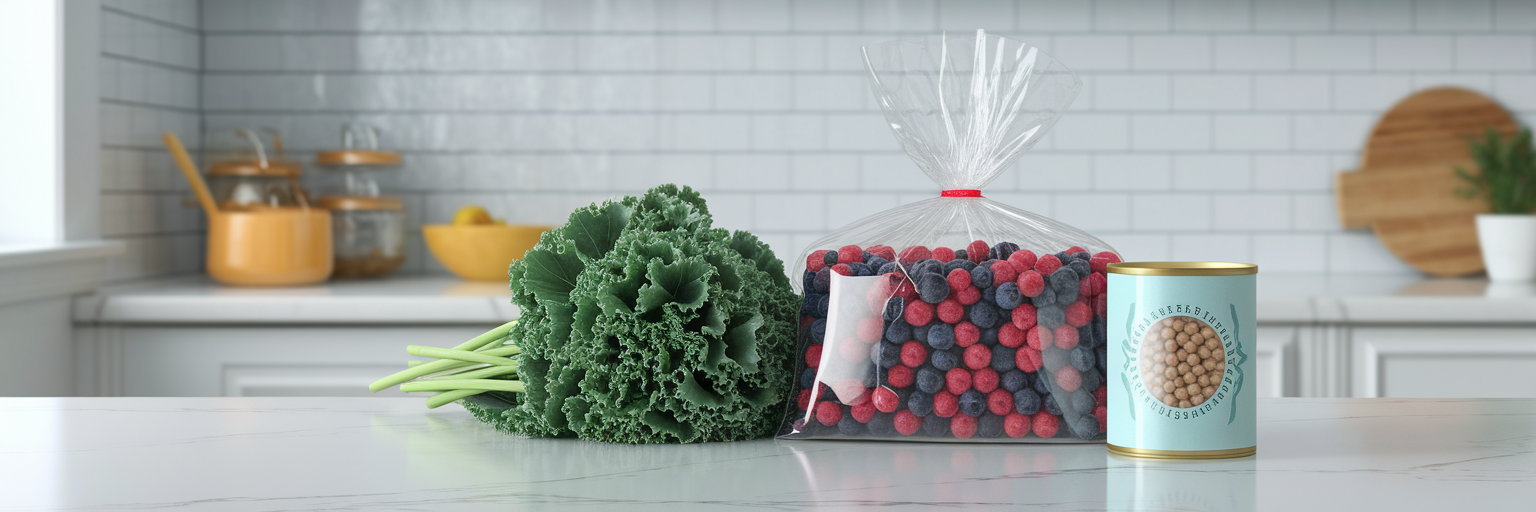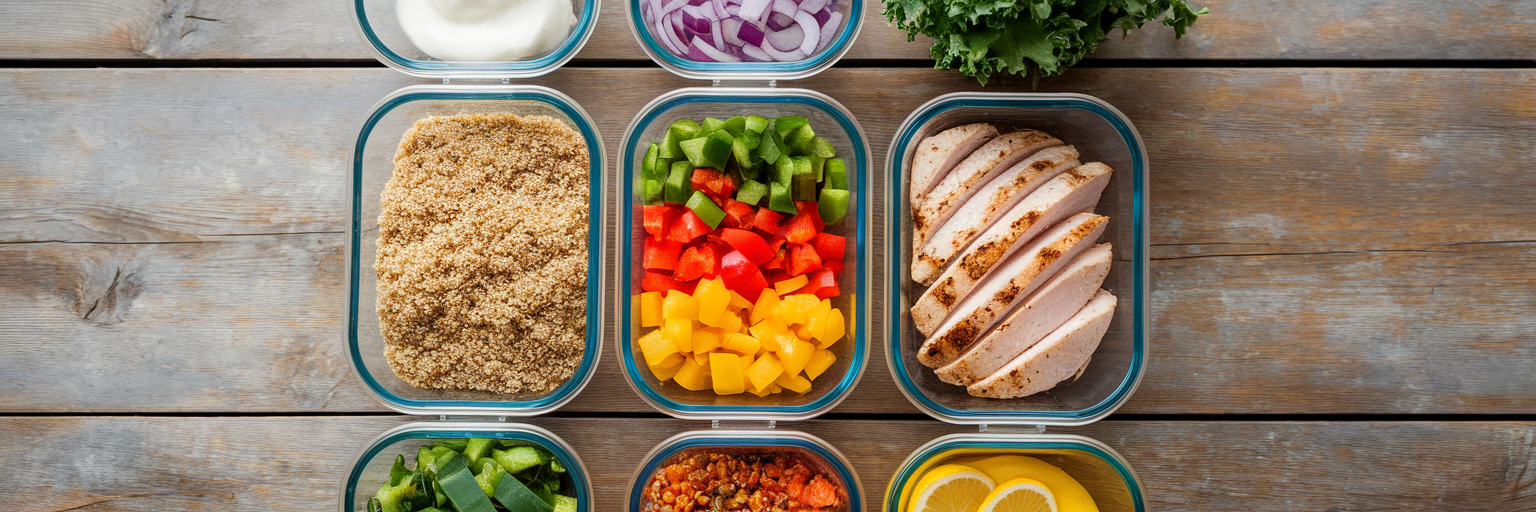The Foundation of Budget-Friendly Healthy Eating
It’s a familiar feeling. You open the fridge, see wilted greens and forgotten leftovers, and feel a pang of guilt. According to the USDA, the average American family throws out about $1,500 worth of food each year. This waste is a quiet drain on our finances, often more significant than the price of groceries themselves. The idea that healthy eating is expensive is a persistent myth. In reality, creating healthy meals on a budget is less about sacrifice and more about smart strategy.
It starts with a few core habits: building a reliable pantry, making savvy produce choices, and using meal prep to minimize waste. These pillars transform your kitchen from a source of stress into a hub of efficiency. This approach is not about restriction. It is about empowering you to cook delicious, nourishing food while keeping your grocery bills in check.
Build Your Pantry with Plant-Based Proteins
Your pantry is your first line of defense against expensive, last-minute takeout orders. A well-stocked pantry built around affordable staples ensures you always have the foundation for a satisfying meal. The stars of a budget-friendly pantry are often plant based protein sources like lentils, beans, and chickpeas. A bag of dried lentils can cost less than a single pound of ground beef and provide protein for multiple meals. Think about it: you can make a hearty lentil soup for a fraction of the cost of a meat-based stew.
Integrating these ingredients into familiar dishes is simpler than you might think. They absorb flavors beautifully and add a satisfying texture. Here are a few ideas to get you started:
Swap half the ground meat in your sloppy joes or tacos with cooked brown lentils.
Mash black beans with spices to create flavorful, firm burger patties.
Use chickpeas as the base for a creamy, satisfying curry like this Spiced Lentil and Chickpea Stew.
Add white beans to pasta sauces to make them more filling and protein-rich.
Alongside these proteins, stock up on whole grains like brown rice, quinoa, and whole-wheat pasta. These items have a long shelf life and serve as the perfect canvas for your meals. As nutrition experts often note, these plant based protein sources are not just affordable but also packed with fiber and essential nutrients, keeping you full and energized. A smart pantry is your secret weapon for consistent, healthy eating.
Choosing the Right Produce for Your Wallet
The produce aisle can feel like a financial minefield, but it doesn't have to be. The key is to be flexible and understand the strengths of fresh, frozen, and canned options. Many of us were taught that fresh is always best, but that isn't the whole story. Frozen produce is often misunderstood. Vegetables and fruits are typically flash-frozen at their peak ripeness, which locks in vitamins and minerals. This means that bag of frozen spinach might be just as nutritious as its fresh counterpart, especially if that fresh spinach has been sitting on a truck for a week.
Cooking with frozen vegetables is a fantastic way to save money, particularly on items that are out of season. A bag of frozen berries for your morning smoothie will almost always be cheaper than a fresh pint in the middle of winter. The trick is knowing when to use each type. Fresh produce is perfect for salads or snacks where texture is important. Frozen works beautifully in soups, stir-fries, and baked goods. Canned goods, like tomatoes and beans, are incredibly convenient and cost-effective for sauces and stews. Just be sure to check the label for "no salt added" or "packed in water" to control your sodium and sugar intake.
| Produce Type | Best For | Cost Factor | Key Consideration |
|---|---|---|---|
| Fresh | Salads, snacking, recipes where texture is key | Variable; low when in season, high when out of season | Highly perishable; requires immediate use or proper storage |
| Frozen | Smoothies, soups, stir-fries, baked goods | Consistent and often cheaper than out-of-season fresh | Flash-freezing preserves nutrients effectively |
| Canned | Sauces, stews, beans, some fruits | Generally the most affordable and shelf-stable | Check labels for 'no salt added' or 'packed in own juice' |
Shopping Seasonally for Peak Flavor and Value
Building on the idea of smart produce choices, timing your purchases can make a huge difference. Shopping seasonally is a simple strategy based on supply and demand. When a fruit or vegetable is in season, it's abundant, and that drives the price down. You’ve probably noticed how cheap berries are in the summer and how affordable squash is in the fall. That’s the food cycle working in your favor.
Beyond the savings, seasonal produce just tastes better. A tomato picked in the peak of summer has a flavor that a winter tomato simply cannot match. It’s also often more nutrient-dense because it has ripened naturally. You don’t need to memorize a complicated calendar. A great starting point is to see what’s on sale at your local grocery store; those front-of-the-store displays are usually filled with seasonal deals. For more specific guidance, the USDA offers a seasonal produce guide online. Another great tip is to visit a local farmers' market. If you go toward the end of the day, vendors are often willing to give you a deal on what’s left rather than pack it all up.
Strategic Meal Prepping to Reduce Waste
We've all been there: you buy a bunch of fresh cilantro for one recipe, and the rest of it wilts in the crisper drawer. This is where meal prepping becomes more than just a time-saver; it’s a powerful tool against food waste. Effective budget meal prepping isn't about eating the same boring meal all week. It’s about being strategic with your ingredients to ensure everything gets used.
There are several flexible ways to approach it:
Batch Cooking: This is the classic approach. Make a large pot of chili, soup, or a casserole on Sunday and portion it out for lunches or dinners throughout the week.
Component Prepping: This method offers more variety. Prepare individual ingredients that you can mix and match. For example, cook a large batch of quinoa, roast a tray of vegetables, and grill some chicken. You can then assemble grain bowls, salads, or wraps in minutes.
Ingredient Chopping: The simplest form of prep. Just wash and chop all your vegetables for the week's recipes. Having onions, peppers, and carrots ready to go makes starting a weeknight dinner far less daunting.
Consider how one ingredient can be stretched. A whole roasted chicken on Sunday can become chicken sandwiches for Monday's lunch, and the carcass can be simmered into a flavorful broth for a soup later in the week. The hour or two you invest in prepping on the weekend pays off by saving you from the temptation of expensive takeout after a long day.
Bringing Your Budget-Friendly Meals to Life
Eating well on a limited budget is an achievable goal. It comes down to a few simple, powerful habits: keeping a well-stocked pantry with plant-based proteins, being flexible with fresh and frozen produce, shopping with the seasons, and prepping ingredients to reduce waste. These strategies work together to help you learn how to save money on groceries while enjoying delicious, home-cooked food.
Once you have your ingredients, technology can help ensure nothing goes to waste. Modern tools can help you turn what you have on hand into exciting meals, preventing that head-scratching moment in front of an open fridge. Instead of wondering what to make, you can instantly find cheap healthy recipes based on the exact items in your kitchen. This approach closes the loop, turning smart shopping into satisfying meals without the stress. Ready to see what you can create? You can browse recipes and get inspired to start cooking with confidence.












